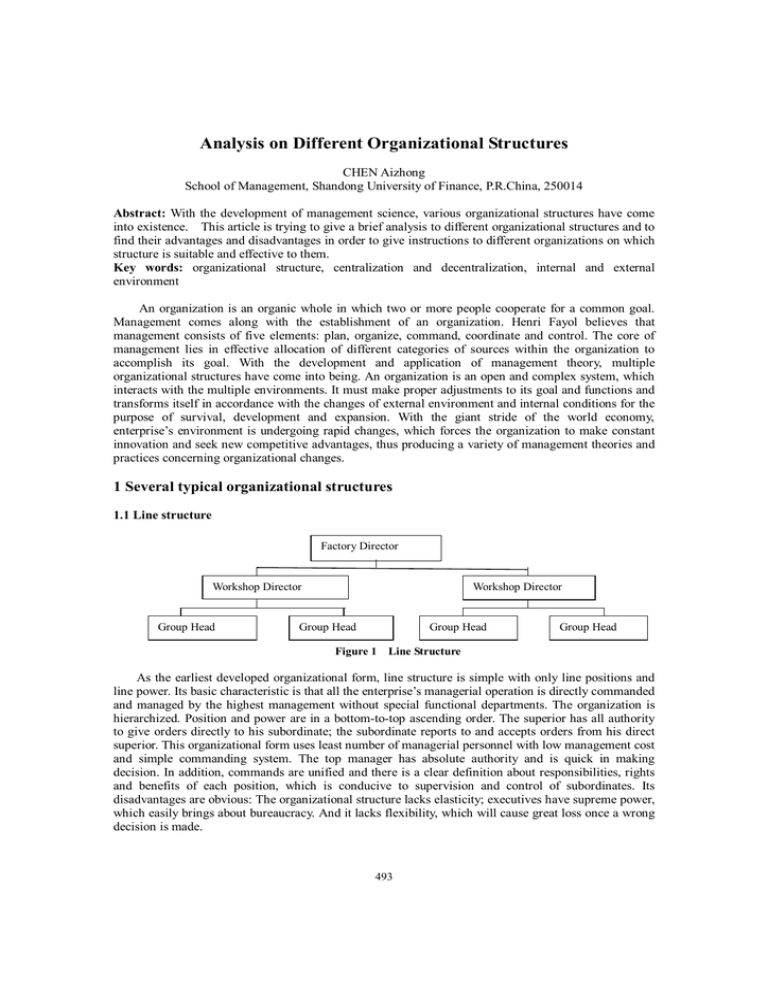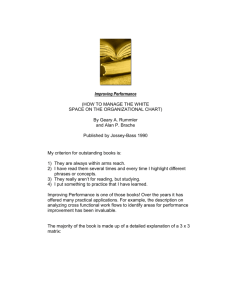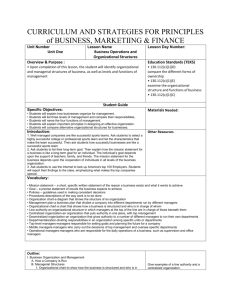Analysis on Different Organizational Structures
advertisement

Analysis on Different Organizational Structures CHEN Aizhong School of Management, Shandong University of Finance, P.R.China, 250014 Abstract: With the development of management science, various organizational structures have come into existence. This article is trying to give a brief analysis to different organizational structures and to find their advantages and disadvantages in order to give instructions to different organizations on which structure is suitable and effective to them. Key words: organizational structure, centralization and decentralization, internal and external environment An organization is an organic whole in which two or more people cooperate for a common goal. Management comes along with the establishment of an organization. Henri Fayol believes that management consists of five elements: plan, organize, command, coordinate and control. The core of management lies in effective allocation of different categories of sources within the organization to accomplish its goal. With the development and application of management theory, multiple organizational structures have come into being. An organization is an open and complex system, which interacts with the multiple environments. It must make proper adjustments to its goal and functions and transforms itself in accordance with the changes of external environment and internal conditions for the purpose of survival, development and expansion. With the giant stride of the world economy, enterprise’s environment is undergoing rapid changes, which forces the organization to make constant innovation and seek new competitive advantages, thus producing a variety of management theories and practices concerning organizational changes. 1 Several typical organizational structures 1.1 Line structure Factory Director Workshop Director Group Head Workshop Director Group Head Group Head Group Head Figure 1 Line Structure As the earliest developed organizational form, line structure is simple with only line positions and line power. Its basic characteristic is that all the enterprise’s managerial operation is directly commanded and managed by the highest management without special functional departments. The organization is hierarchized. Position and power are in a bottom-to-top ascending order. The superior has all authority to give orders directly to his subordinate; the subordinate reports to and accepts orders from his direct superior. This organizational form uses least number of managerial personnel with low management cost and simple commanding system. The top manager has absolute authority and is quick in making decision. In addition, commands are unified and there is a clear definition about responsibilities, rights and benefits of each position, which is conducive to supervision and control of subordinates. Its disadvantages are obvious: The organizational structure lacks elasticity; executives have supreme power, which easily brings about bureaucracy. And it lacks flexibility, which will cause great loss once a wrong decision is made. 493 1.2 Functional structure General Manager Functional Dep. 1 Functional Dep. 2 Workshop director Functional Dep. 3 Workshop director Functional Group Group Head Functional Dep. 4 Workshop director Functional Group Group Head Group Head Figure 2 Functional Structure Russel Ackoff was the first to put forward functional structure and put it into trial practice: on the principle of division of responsibility, form functional departments within the organization and assign corresponding administrators to take charge. Within their business scope, these functional departments have the power to give orders and direction to their subordinates. Therefore, the subordinating administrators shall submit themselves not only to their superior administrative management but to their superior functional departments as well. The leading advantage of functional structure lies in that it is able to bring experts into full play and make up for the deficiency of the leadership of administrators at all levels. Its disadvantages are that multiple leadership levels will interfere with the centralized and unified command, go against the clear division of the responsibilities and authority on the part of every administrative manager and each functional department. Besides, each functional department emphasizes the importance of their own department, which will cause conflicts between departments. 1.3 Line and functional structure By line and functional structure, it is meant that necessary functional department is established at each management level within a line-structure organization for the purpose of assisting the managerial personnel at this level. On one hand, the administrators at each level have corresponding functional departments as assistant so that they can play an important role in professional management and reduce errors in decision-making. On the other hand, within each managerial organ, centralized and unified direction and management are maintained, thus raising the management efficiency. The deficiency for this structure lies in the difficult coordination between functional departments and addition of managerial personnel and operational cost. Generally speaking, line and functional structure is suitable to the organizations which are small in scale, unitary in production and centralized in one area. General Manager Functional Department Functional Department Workshop Head Workshop Head Functional Group Functional Group Group Head Workshop Head Group Head Group Head Figure 3 Line and functional structure 494 1.4 Multidivisional structure A typical structure of decentralization, multidivisional structure has become a commonly adopted organizational structure by extra large enterprises and multinational enterprises. Its features are like this: Establish business divisions according to the products that enterprises manufacture or different production bases. These business divisions are independent profit centers, which, under the leadership of head office, carry out the system of independent economic accounting and sole responsibility for their profit and loss. The advantages of this structure are that it has improved the decision-making structure of the organization and reduced the size of accounting unit, which is helpful to large enterprises in disintegration, decision-making management, stimulating the enthusiasm of each divisional department and coordinating the contradictions between coalition and specialization. The disadvantages of this structure are as follows: From the point of view of the whole enterprise, the repeated establishment of functional departments will increase operational cost; ineffective control will cause independent divisional departments to develop into “small companies”. In addition, the inappropriate strengthening of the departmental interest will bring about a situation in which each department works for itself, and coordination becomes difficult and the overall strategic goal of the company is hard to accomplish. On the whole, multidivisional structure is most suitable to large, multi-sectional and interregional enterprises. For example, General Motors Corporation adopts this organizational form. General Manager Functional Dept Functional Dept Business Division Functional Dept Business Division Business Division Functional Dept Functional Dept Factory Functional Dept Factory Factory Figure 4 Multidivisional structure 1.5 Matrix structure Within the line and functional structure, add a horizontal project management system, thus forming a matrix. In order to complete a project, concerned personnel are transferred from functional divisions to form project department, which includes different kinds of professionals who are to work together for a specific project. When the project is accomplished, the professionals will be assigned different roles and the project department will come to an end. Each project leader will be under direct leadership of the factory director. Project members are under the leadership of both project leader and those of their original functional departments. They are linked with original functional departments in organization and business. General Manager Functional Dept Manager of project A Functional Dept Functional Dept Functional Dept Members of project team Manager of project B Members of project teamsuch a structure, members will Matrix structure is not a long-term organizational structure. Within Figure 5 Matrix structure 495 be led by two executives. This structure is flexible in personnel arrangement and well adaptable to changing. Grouping different departments and professionals together will give full play to technical specialists’ merits, improve techniques and management and benefit the development and research of new technology and new products. This structure has its deficiencies, that is, it has poor stability and unclear responsibilities and power. Members are under double leadership. When contradictions occur between departments at different levels, management order will be in chaos, which will affect organization efficiency. Compared with traditional structures, matrix structure is preferred by team members. They say that this structure facilitates the establishment of good relation and accomplishment of project. Besides, R. Anderson points out that matrix structure is more helpful to decentralization, authorizing power to members, doing well in customer services and more effective in accomplishing goals. To accomplish a project, the specialists in functional departments are transferred to a certain specific project to form a project team, thus making full use of different resources, expertise and experience and greatly increasing efficiency. 2 Essentials for organizational structure design Three elements have influences on the design of organizational structure: environment, strategy and technology. 2.1 Environment Environment involves two parts: general environment and specific work environment. The complexity and changeability of environment determines its uncertainty. The design of organizational structure is closely related to the uncertainty of its environment. For departments with definite environment, the design of organizational structure may use the mechanic structure that is relatively stable. While for industries and departments with changing environment, the flexible organic structure is preferred. 2.2 Technology Technology in this context refers to the process in which raw materials are finally turned into finished products or intelligence and mechanical force of service. Generally, it falls into three categories: jobbing work, mass production and long-term continuous production. Therefore, organizational structures shall be designed to suit the characteristics of technology. 2.3 Strategy Strategy refers to the overall objective that decides the nature and fundamental direction of organizational structures. Successful strategy of an enterprise is the key to facing market competition and sustainable development. In different stages, enterprises shall use different strategies as well as organizational structures corresponding to them. Reasons for organization changes An organization must, depending on changes of external environment and internal conditions, make appropriate adjustments to its objective and functions and constant changes for survival, development and expansion. Organizational changes refer to the practice of an organization to make timely adjustments to its structure and functions in accordance with the changes of external environment and internal conditions so as to increase its competitiveness for survival and development. 3 Changes in strategy and organizational structure A. D. Chandler, American scholar, is the first to make a study of the relationship between strategy and organizational structure and publishes a book entitled Strategy and Structure: Chapters in the history of the Industrial Enterprise, in which he studies the history of 70 companies, especially some American large companies such as Dupont and General Motors Corporation. He discovers that in the early stage 496 companies like Dupont tends to build centralized organizational structure, which is especially suitable to produce and sell limited products. When these companies add new product lines, purchase advanced industry and build their own distribution system, enterprises seem too much complex for highly centralized structure. In order to maintain the effectiveness, organizations must reform. Therefore, he believes that organizational structure must comply with strategy and any change in strategy will cause modifications to organizational structure. Gilbreth and Gail Carson put forward more specific guiding principles to better combination between strategy and structure: 1. For companies focusing on one single business or owning a leading business, functional structures are preferred. 2. Companies dealing with correlated products or a variety of services shall adopt multidivisional structure. 3. Companies dealing with non-correlated products or a variety of services shall take compound (or H-form) structure. All in all, to effectively carry out a new strategy needs either a new organizational structure to match it or to reform the organization to form new suitable organizational structure. Enterprises shall not formulate their strategy in accordance with external environment and then regulate their original organizational structure based on the newly-formulated strategy. References [1] Arthur A. Thompson, Wilianm E. Fulmer, A. J. Strickland III. Strategic Management (Fourth edition), published by Irwin Publishing House, 1992. [2] Peter M. Senge. The Fifth Discipline, published by Doubleday, New York, 1994. [3] Paul W. Beamish. International Management, published by Irwin Publishing House, 1991. [4] Zhou Jianlin. Management Textbook, published by Shanghai University of Finance & Economics Publishing House, 2001. The author can be contacted from e-mail : pxzxchen@126.com 497






